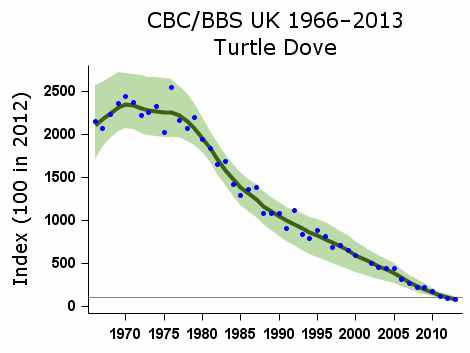Turtle Dove - always a stunning site in a british summer (Pete Walkden image)
Patrick Barker, an arable farmer in Westhorpe, Suffolk, who took part in the study, said: 'It’s been great to be involved in this research and to find out how we can give Turtle Doves a hand. What was particularly striking was that the areas they prefer don’t look as you’d expect.

Turtle Doves have been declining since the 1970's (© BTO)
'For example, we learned that bare patches on the ground amongst the vegetation give them space to land and move around.
'I hope that our work here will encourage other farmers to do the same, and that this will help Turtle Doves return to the countryside.'
This new management option is part of a wider ‘Turtle Dove package’, deployed within the Higher Level Stewardship scheme agreements on farms supporting Turtle Doves (or with Turtle Doves nearby), which seeks to provide foraging habitat in proximity to nesting Turtle Doves. The other options in this package include cultivated margins, fallows that promote seeding plants, and scrub and hedgerow management for nesting. The options a farmer selects will depend on local land characteristics and farming practices.
Tony Morris, Senior Conservation Scientist, RSPB Centre for Conservation Science said: 'This research helps our understanding of how to provide food for Turtle Doves on farmland where the original sources of seed food have long since vanished but without unduly disrupting modern agriculture.
'Agri-environment schemes offer the best and perhaps last hope for this iconic species. We're hopeful that, together with farmers and our partners in Operation Turtle Dove, we can reverse the decline of this bird and secure its long-term future in Britain.'
Jenny Dunn, Conservation Scientist, RSPB Centre for Conservation Science, said: 'The results of this research show that it is possible to create a 'farmed' habitat structure similar to that used by Turtle Doves historically - an area with a patchy structure containing both seed-rich plants and bare ground to allow Turtle Doves to access the seed.'
This study is one of many research papers that was published from scientists at the RSPB’s Centre for Conservation Science (CfCS), which celebrates its one-year anniversary this month. The team at the RSPB CfCS aims to discover practical solutions to 21st century conservation problems by identifying important problems, discovering their causes, testing potential solutions and ensuring they work when implemented.
RSPB - March 2014


No comments:
Post a Comment